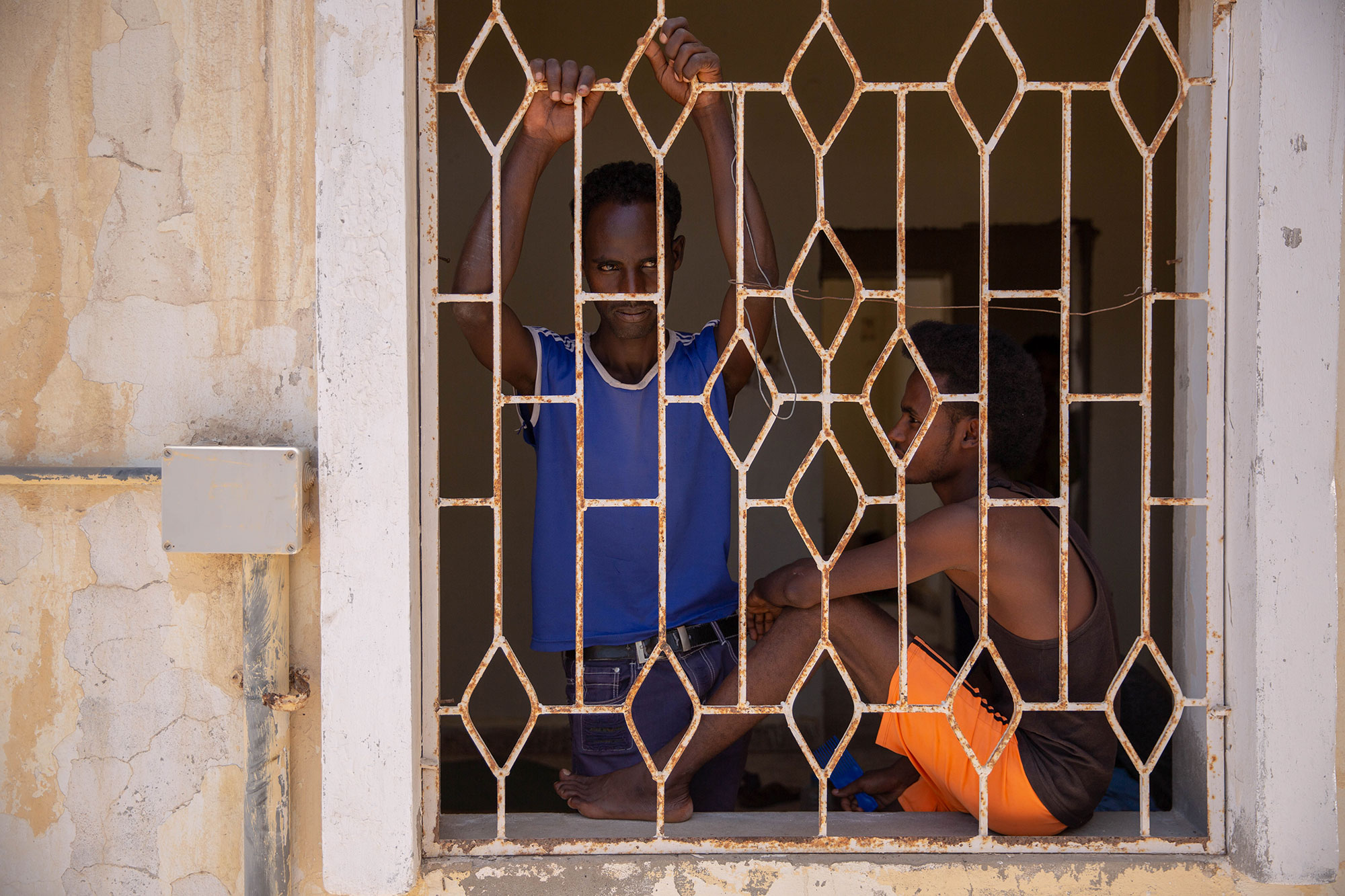From Bolivia to Berlin, Bosasso to Bangkok, by the middle of July an IOM report confirmed that more than 2.75 million migrants were stranded in the midst of their migratory journeys as a result of COVID-19, often in precarious situations.
A widow from Myanmar struggled to feed her family in Thailand; an Ethiopian mother of six searched for a husband missing in Somalia; a couple and their one-year-old daughter traveled 1,800 km by bus through Chile only to find their passage home blocked.
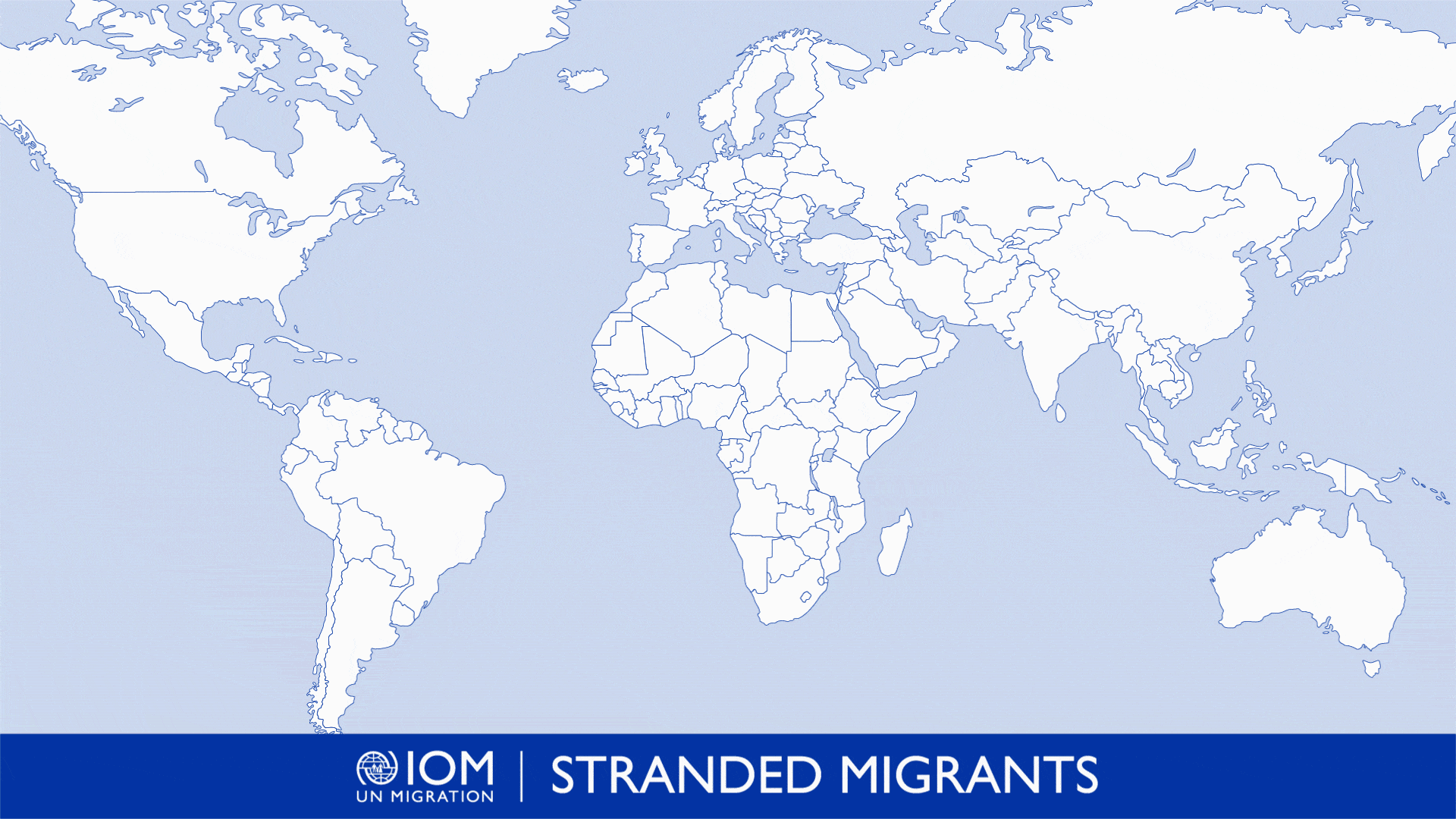
The reasons were many: roughly 220 countries imposed over 90,000 travel and mobility restrictions, unemployment in sectors traditionally filled by migrant labour soared pushing many to make the hard decision to return to their countries of origin, while others faced the threat pushbacks, or deportation as visas and permits expired.
While some nations responded by extending health care and social support services to migrants regardless of their legal status, others did not. Stigmatization and xenophobia rose, and the risk of detention in already overcrowded facilities, and homelessness, grew.
Since that time, the types of dialogues between nations encouraged by the Global Compact for Safe, Orderly and Regular Migration has allowed hundreds of thousands of migrants to return home in a secure and dignified manner while addressing the important public health issues posed by COVID-19.
On International Migrants Day 2020, we revisit the stories of stranded migrants in 17 countries and call for further cooperation to ensure they are fully integrated into COVID-19 planning and provided equitable access to vaccines.
Thailand | Eastern Migration Route | Egypt | Zimbabwe | The Sahel | Georgia | Russian Federation | Germany | United Kingdom | Chile | Panama | Mexico
By mid-July, IOM estimated nearly 977,000 migrants were stranded in the Asia Pacific.
Some of the defining images of the global mobility lockdown were those of the tens of thousands of migrant workers pouring across the Thai border into Myanmar, Cambodia and Laos in late March. In a three-week period prior to sweeping border closures, an estimated 260,000 people left the country and an unknown number continue to do so through irregular routes.
There are between four to five million migrant workers in Thailand, drawn to labour-intensive sectors such as agriculture, fisheries & food processing and construction, and the country’s vibrant tourism industry; roughly 2.7 million are registered with the government.

(L-R) KYAW lives with his wife and their 11-month-old twin boys. They are from Rakhine State in Myanmar and have been living in Thailand for almost six years. Kyaw works in a fish factory but he has been out of a job since March.
Also from Rakhine State, KOH left his wife in Myanmar one year ago to move in with his adult son and look for work. He laboured on a construction site for about three months before the State of Emergency was declared but has only had a week’s paid work since March.
ZAR ZAR recently moved in with her mother, after her husband, a fisherman, died at sea. She has two sons aged three years and three months. She had just started fish grading work before COVID-19 and has been without a job since late March.
SAN migrated from Dawei, Myanmar 20 years ago. She’s been unemployed since a local factory closed in March. She and her husband, who was laid off from his job repairing fishing boats, haven’t seen their children since inter-provincial travel restrictions came into effect and are now living with their grandchildren.
In early April, the Thai Chamber of Commerce estimated that about seven million jobs had already been lost and that were the pandemic to persist the number could climb to 10 million: there are 38 million people in the Thai workforce.
IOM is trying to meet the basic needs of stranded migrants; over 200 particularly vulnerable families are receiving monthly food and hygiene supplies but, as is the case in all of the countries featured here, the needs are high and there are simply not enough resources available.
EASTERN MIGRATION ROUTE
Farhiya and her eight-month old son await return assistance to Ethiopia at a reception centre in Bossaso, Somalia. She arrived in the country five months ago searching for her husband who’d left without a word. She heard rumors that he was looking for work in Saudi Arabia, so Farhiya hitchhiked to Somalia with her youngest child and walked desert roads in a failed attempt to find him. “I have five other children to look after, so I’m going home.” IOM Photo/Muse Mohammed
Scores of migrants, mainly from landlocked Ethiopia, pass through Bossaso in neighbouring Somalia along the so-called Eastern Migration Route from the Horn of Africa, across the Strait of Hormuz, through conflict-torn Yemen to the Gulf, principally the Kingdom of Saudi Arabia, in search of work every year.
Two-thirds of the 138,000 people who crossed the busiest maritime migration route on earth in 2019 boarded smugglers vessels here in Puntland state.
Despite border closures and other movement restrictions that stranded at least 2,500 people in the region, migrants continued to attempt the journey. IOM documented approximately 600 reaching Bossaso in Puntland in a single day in April. But now, there’s nowhere to go.
“I have been here for around three months,” said 19-year-old Fassil from the Tigray region in Ethiopia. “The coronavirus has changed everything. I cannot continue, I cannot go back because all borders are closed.”
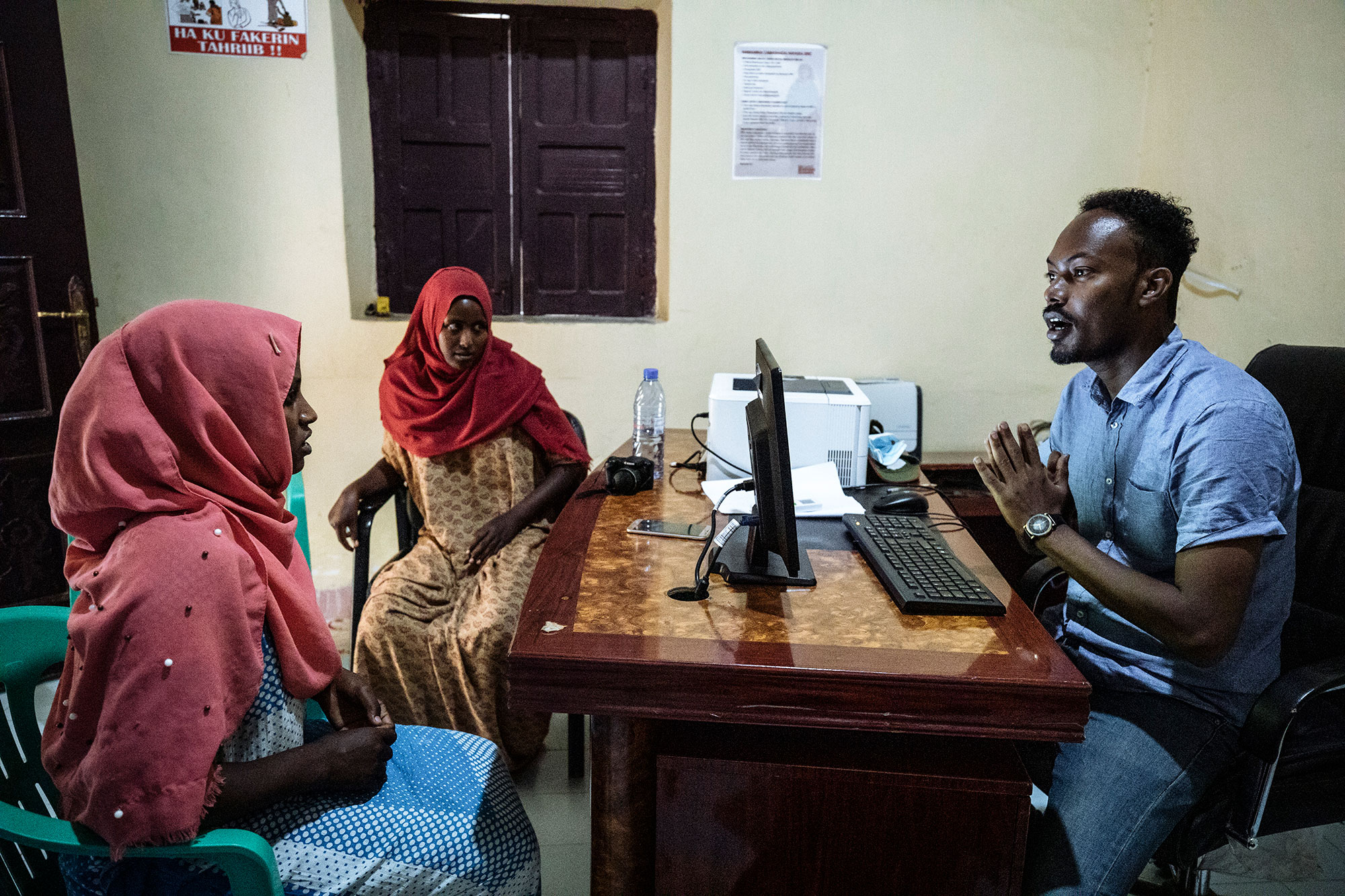
IOM receives hundreds of migrants stranded in remote areas in Somalia every week, many in need of medical assistance. Some were abandoned by smugglers and traffickers; others endured much on their journeys and decide to return home. At the Migrant Resource Centre, IOM staff provide clothing, shelter for separated and unaccompanied minors, health assistance, as well as support to return voluntarily to their country of origin. IOM Photo/Muse Mohammed
Anti-migrant xenophobia and stigma fueled by misinformation are growing since the first cases of COVID-19 were reported in Puntland in mid-April.
“We do our best to help them... however, if their numbers increase, and they cannot cross the sea due to the closure of borders, their well-being will be in great danger,” says Ahmed Shirie, the Chairman of the Ethiopian community in Bossaso who are already assisting 400 stranded people.
The road to Djibouti. Photo: IOM Photo/ MOHAMED ALI Moustapha
While the majority of migrants pass through Bosaso, roughly 38 percent of migrants will depart form Djibouti, a second mainland African terminus of the Easter migration route.
As is the case with its sprawling southern neighbour, COVID-19-induced border closures, movement restrictions and a crackdown on smugglers plying the route has stranded over 1,500 Ethiopian migrants in 25 different locations across the country as of April 2020.
IOM's report on stranded migrants globally concluded COVID-19 mobility restrictions stranded over 1.2 million people in the Middle East and North Africa, the overwhelming majority in the Gulf.
Through more than five years of conflict, Yemen remained the corridor through which tens of thousands of migrants from the Horn of Africa pass every year on their journey to Saudi Arabia in search of work.
While the numbers plummeted from 11,101 in January to 1,725 in April, movement restrictions and increased vigilance along the border resulted in many thousands of people being stranded in a war zone, unable to advance to their destination or retreat to safety. An increasing number face crowded and often unsanitary conditions in transit, detention and quarantine centres.
As fears of the virus increased and more and more people saw their loved ones and neighbours become ill, migrants were increasingly stigmatized as “transmitters of disease”. In the past they have been blamed for bringing cholera to Yemen.
There is no evidence that one group is more responsible for the transmission of COVID-19 or cholera than another. The xenophobia and scapegoating campaigns lead to retaliation against migrants, including physical and verbal harassment, forced quarantine, denial of access to health services, movement restrictions, and forced movements to frontline conflict and desert areas, leaving them stranded without food, water and essential services.
Migrants are often the first to be laid off during difficult times, leaving vulnerable people more exposed than ever, reliant on assistance for even basic necessities.
The economic fallout from COVID-19 fell particularly heavily on migrants in Egypt.
Their exact numbers are unknown but the possibility of work has drawn thousands of Sudanese, South Sudanese, Yemenis, Ethiopians, Eritreans and others to Cairo and Alexandrea in particular.
“Food is a grave concern for all right now,” said Muzzamel Soliman, a Sudanese Fulani leader in Cairo. “Many have lost their jobs and had to move houses as they no longer have any source of income. Some can barely feed themselves or their families.”
In cooperation with the Egyptian Red Crescent, IOM Egypt has provided thousands of stranded migrant families with food boxes containing rice, pasta, beans, sugar and other essential basic needs like hygiene kits in the country’s two largest cities. The Organization operates a hotline to refer migrants to financial and legal services, medical screenings, and housing allowances for urgent cases.

Abandoned by smugglers on their journey to South Africa, these Malawian migrants returned home recently with IOM's assistance.
South Africa is home to approximately 4.2 million migrants drawn by the country’s robust economy from as far away as Ethiopia. The nation-wide lockdown produced huge socio-economic impacts and social protection needs in a country whose economy was contracting even before the virus was first reported. The migrant labour force which primarily operates in the informal sectors and depended on daily income to meet their needs, faced dire food security, shelter, health and protection challenges.
COVID-19 stranded at least 100,000 migrants in the region according to IOM's July report.
Neighbouring Zimbabwe expected upwards of 20,000 returnees to arrive from Botswana, Zambia, South Africa, and Mozambique in addition to the 3,500 who managed to enter the country as of May 12, stretching the capacity of provide services in a country already home to more than 43,000 internally displaced people at that time.
A transit country for migrants attempting to travel to South Africa, Zimbabwe also hosts large numbers of stranded migrants. One hundred undocumented Malawian nationals abandoned by smugglers voluntarily returned home by bus with IOM’s assistance in mid-May.
Border closures have forced a halt to the seasonal movements of transhumant herders and their families, an estimated 20 million people in West and Central Africa. IOM Photo/Geoffrey Reynard
A nearly 6,000 km-wide belt of land stretching from the Atlantic Ocean to the Red Sea, the Sahel encompasses more than a dozen countries. Here, mobility is a critical millennia-old livelihood and adaptation strategy that allows millions to survive and thrive in one of the world’s harshest environments. Government-mandated restrictions on movement, notably putting a halt to bustling cross-border trade and “non-essential” activities, has impacted households across the region.
Over 24,000 people including migrants hosted in transit centers and herders stranded at borders are currently waiting for their fates to be settled and for the borders to reopen.
To mitigate the disruption to its activities, including the provision of assistance to stranded migrants, IOM is mainstreaming COVID-19 related activities into existing projects and when possible, continuing its lifesaving search and rescue efforts and other critical operations.
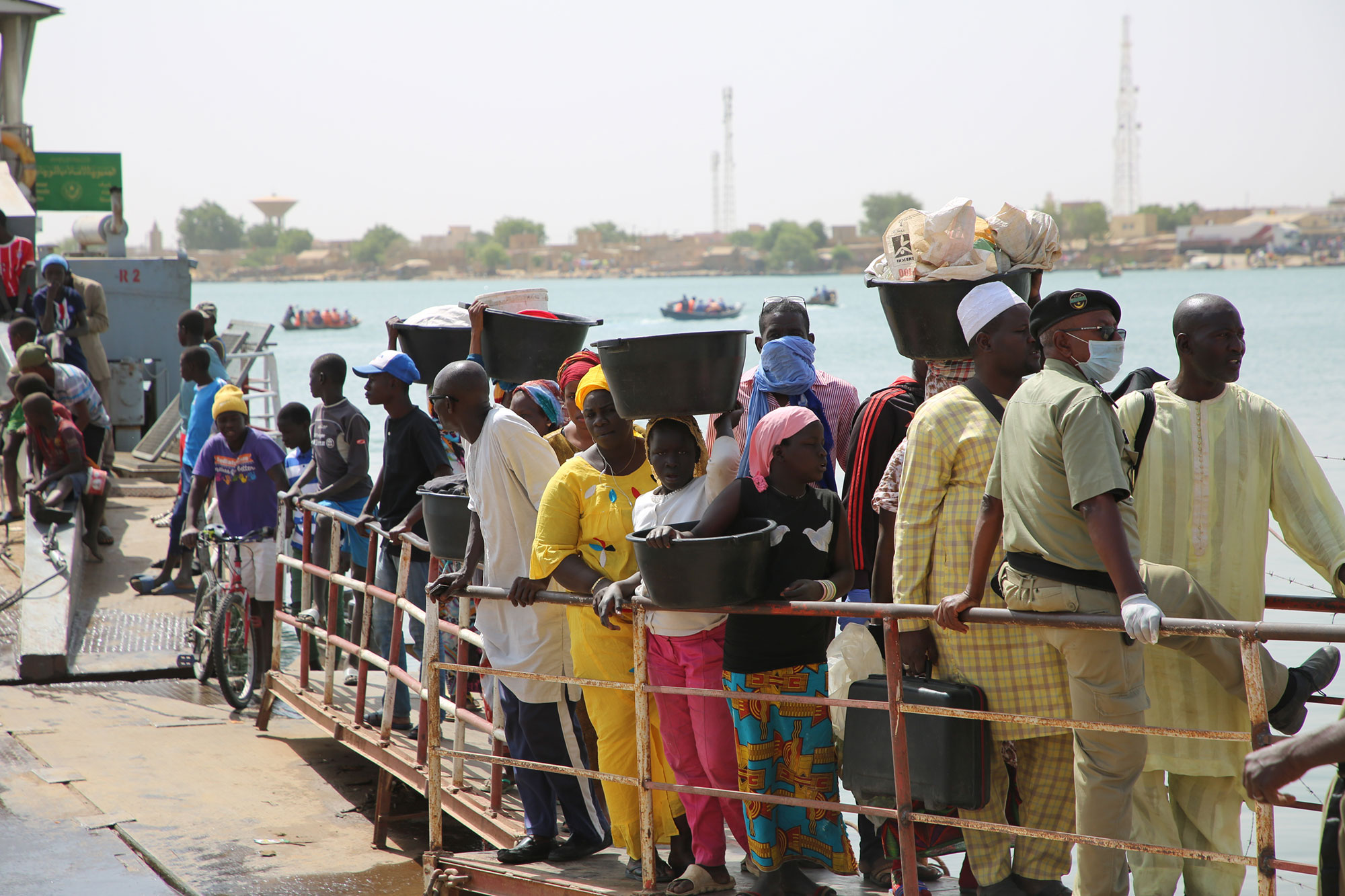
Border officials were being trained and equipped at the Rosso river border post between Mauritania and Senegal before the lockdown. IOM Photo/Ciré Ly 2020
It is estimated that more than 1,500 migrants are stranded in Mauritania, primarily Malians and Senegalese, roughly one-quarter of all migrants stranded in West and Central Africa according to IOM's report on the global phenomena. Without any alternative perspective, they are worried about their future and that of their loved ones.
Key will be the timely and responsible reopening of the border crossings into Senegal, balancing the desire of people to return home and the impacts the closures have had on many communities who rely on cross-border trade, and the need to address significant public health concerns related to COVID-19.
IOM is providing training and medical and protective equipment to Mauritanian authorities to encourage the reopening of border posts, shuttered since 25 March.
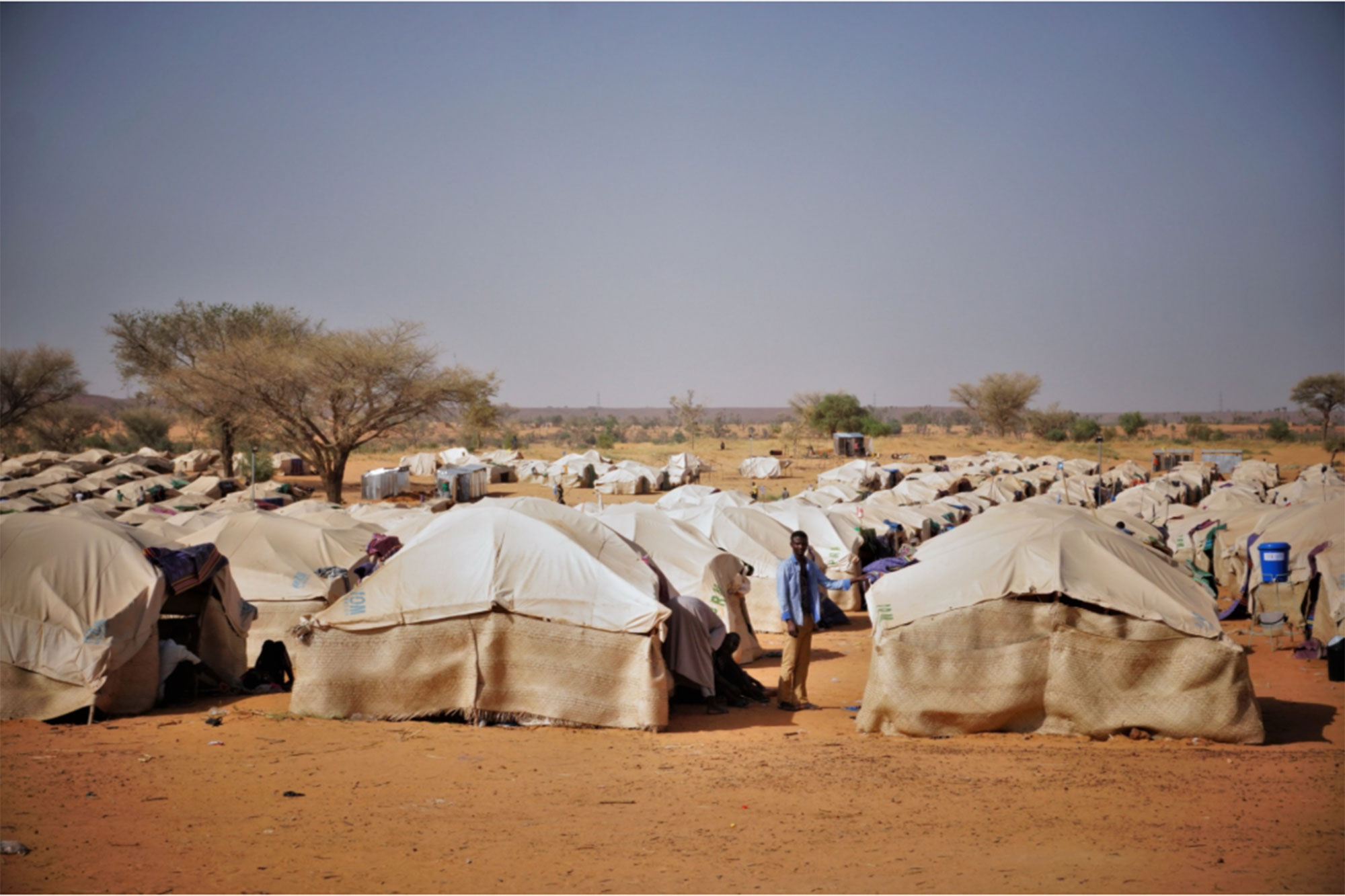
IOM-supported humanitarian site in Niamey where more than 1,300 Nigeriens are completing their 14-day COVID-19 quarantine. IOM/Monica Chiriac
Almost 3,000 migrants had asked IOM to assist with their voluntary return home prior to Niger closing its borders in mid-March.
While there have been no confirmed cases of COVID-19 among these migrants, frustrations are growing due to lengthy stays in overcrowded transit centres. Niger and some of its neighbours have already agreed to the creation of a humanitarian corridor to organize the safe, voluntary return of migrants, approvals are still pending from countries of origin guarding against the spread of the virus.
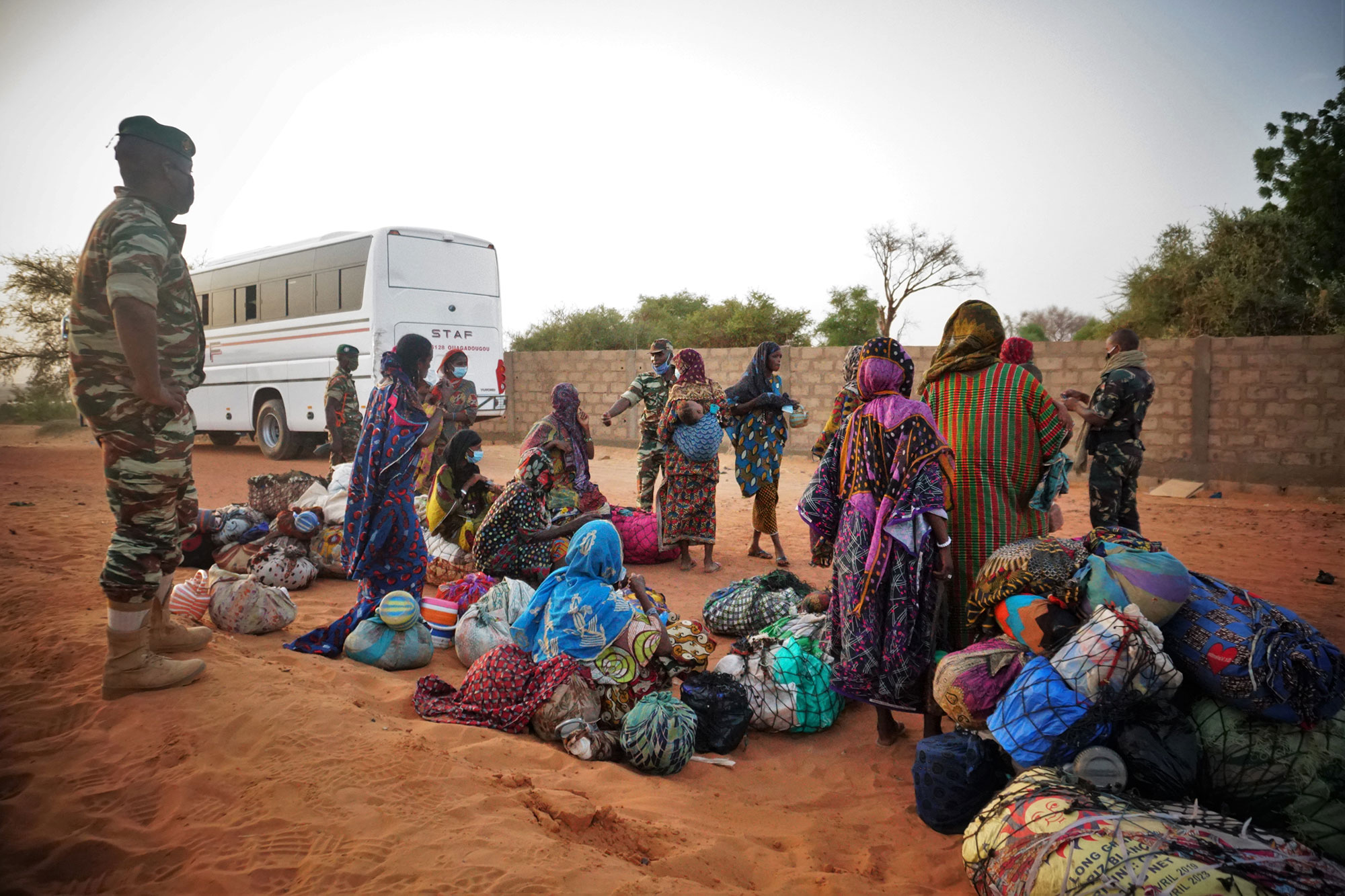
Some of the more than 1,300 Nigeriens who fled clashes in gold mining areas in the south of Burkina Faso. IOM Photo/Monica Chiriac
Over 1,300 Nigeriens to fled clashes in a gold mining region in the south of Burkina Faso in late April, hoping to make it to Ouagadougou, before continuing on to Niamey, the Nigerien capital. IOM has provided cash assistance for food, screened and registered the group, and is working with the national authorities to assist their voluntary return.
The closure of universities in Cameroon stranded more than 2,000 Chadian students for weeks. A bilateral agreement between the two governments allowed the students to return to Chad in early-May, where they were quarantined for two weeks. IOM has chartered buses to help them return to their home communities after negotiating travel special authorization for the groups across several administrative regions.

Dali, a recently returned migrant to Georgia, has adapted her IOM-supported business to sew facemasks for health workers.
By mid-July, close to 60,000 migrants were stranded in South Eastern Europe, Eastern Europe and Central Asia.
As well as providing physical support to migrants stranded in Georgia, IOM ramped up social media and virtual assistance. A live online consultation session organized by the Ministry of Foreign Affairs allowed IOM to talk directly to 50,000 migrants in the EU, Turkey, Israel, Russia, and more.
Over 500 questions were asked by stranded migrants during the session, focusing on how to get home, the implications of overstay in the EU, post-COVID-19 travel and employment opportunities back home.
“Migrants stranded abroad due to COVID-19, especially irregular labour migrants, are in need of constant access to updated information about return options, COVID-19-related restrictions and future migration perspectives”, noted Anna Kakushadze who ran IOM’s part of the consultation.
Migrants stranded by border closures at Novosibirsk Airport in the Russian Federation.
As the COVID-19 pandemic started to take hold thousands of Kyrgyz labour migrants found themselves without jobs, salaries or a place to live.
When they decided to return home many became stranded in airports or on the borders of the Russian Federation, Turkey, Kazakhstan and UAE.
IOM’s offices teamed up to distribute masks, gloves, antiseptic, hot meals and provide a place to sleep in airports in Moscow and Novosibirsk.
A statement from IOM Kyrgyzstan noted that stranded migrants were vulnerable to COVID-19 “and also to exploitative practices. Data on past crises revealed that criminals, employers and others can use the opportunity to exploit migrants by cutting or withholding wages, threatening to report migrants to authorities, and exploiting them in other ways.”
Photo: Imre Tömösvari/Unsplash
Mid mid-summer, IOM data revealed more than 202,000 migrants were stranded in Europe and unable to return due to COVID-19 mobility restrictions.
In the wake of the 15 March closure of the border between Germany and Poland, all Polish citizens returning home were ordered into a compulsory 14-day home quarantine. That put thousands of cross-border workers and students in a difficult situation as they had to choose between their work and returning home.
At the time, some border regions were offering a Euro 40-65 daily stipend to cover meals and hotel rooms to encourage Polish commuters to remain in Germany.
Regulations were loosened to allow Poles who work or study in Germany to avoid quarantine upon their return. However, certain professional groups including doctors, nurses, pharmacists and geriatric nurses, were excluded from the regulation and were still being quarantined at that time.
Oxford Circus. IOM Photo/Muse Mohammed
The significant contributions migrants in the UK made in critical areas in the fight against COVID-19 are well documented.
However, the crisis exacerbated the situation for many others who’ve been made more vulnerable due to their status. Despite warnings from IOM and prestigious journals like The Lancet advocating for migrants to be included in national health and social services as a public health priority, an estimated one million undocumented migrants were at risk of not being able to access adequate health care, and cope with the impacts of the crisis.
Those who were employed were typically found in the sectors most affected by the crisis such as hospitality and retail, or to be self-employed with temporary work and precarious livelihoods.
Reduced services are negatively impacting on those applying for the EU settlement scheme, while few public funds are available for needy EU citizens who have lived in the UK for less than five years.
There are roughly 3,000 migrants of different nationalities stranded in northern Chile, part of the more than 37,400 IOM reported in its July survey of stranded migrants globally.
Among them were Bismar Núñez and Eleuteria Barja and their one-year old daughter Jazmín, who traveled roughly 1,800 kilometers by bus from Chile’s capital Santiago, to Iquique 300kms from the Bolivian border.
Like hundreds of their countrymen, the couple wanted to return home.
Before being taken to shelters provided by the Government of Chile, they spent their nights on the streets or in informal settlements, battling frigid conditions 3,700 meters above sea level while waiting for the chance to cross the border.
In an effort to manage the public health challenge presented by COVID-19 both the governments of Bolivia and Chile agreed that the groups will be quarantined prior to crossing.
In coordination with the government and civil society partners, IOM Chile has been providing stranded migrants in the informal settlements with emergency assistance, including temporary accommodation for the most vulnerable, food and non-food items like tents and blankets.
IOM has documented approximately 7,700 cases of stranded migrants in Central America and the Caribbean.
Among them are more than 2,500 people stranded in Panama after arriving from Colombia through the Darien Gap. They remain in three overcrowded stations managed by the Panamanian National Border Service in one community in the Darien province.
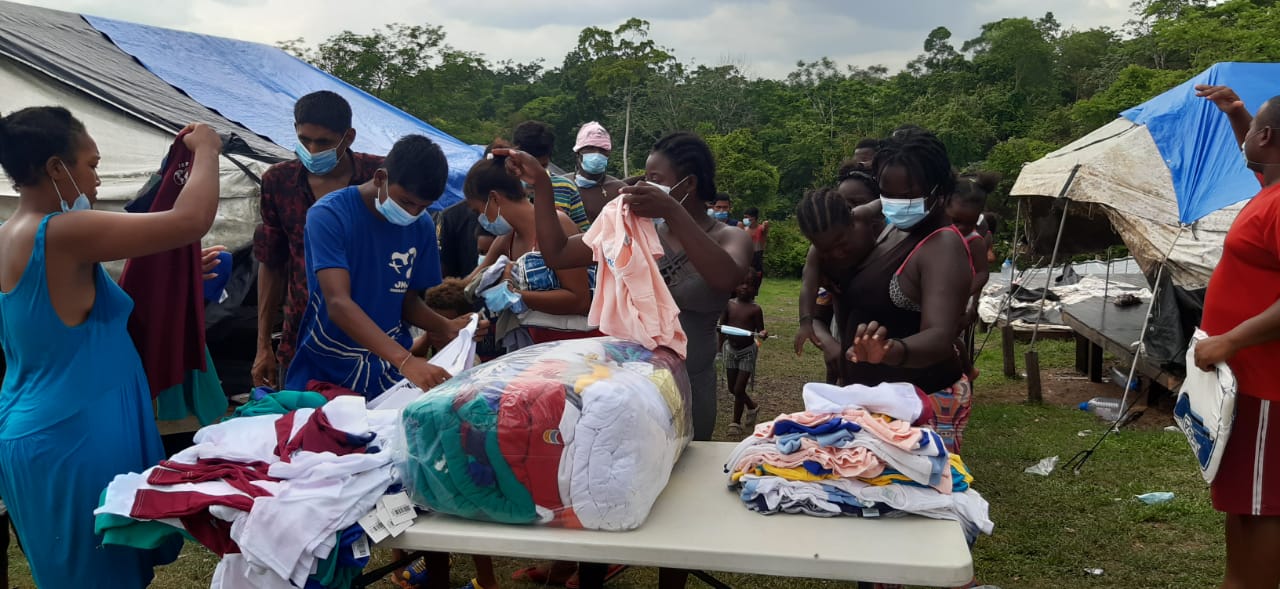
The migrants are usually kept in these facilities for brief periods and taken to the Costa Rica border as part of a “Controlled Flow” agreement between the two countries which allows for the safe passage of 100 irregular migrants daily from Panama to its western neighbour. That agreement is currently suspended, stranding migrants in Panama for over two months.
Most of the migrants come from Haiti, but there are small groups from Cuba, and from as far away as the Democratic Republic of the Congo, Yemen and Bangladesh.
The Government of Panama, with support from IOM and other organizations, is constructing new accommodation centres to provide security for migrants stranded on its territory.

Migrants in Mexico queuing to buy food at a shelter while awaiting their assisted voluntary return home.
In late April, the Mexican government releasing people from its migrant detention centers based on recommendations from the United Nations, including a group of 74 Salvadoran migrants from the Acayucan Migratory Station in Veracruz state. Local authorities in Oluta city were uncomfortable with the move as the migrants were taken into the shelter late at night, without previous notice.

Final predeparture screening at the airport.
IOM stepped into a familiar role, working with both the Mexican and Salvadorian governments to organize an Assisted Voluntary Return (AVR) effort to get them home safely and in a dignified manner, while ensuring public health concerns are suitably addressed.


